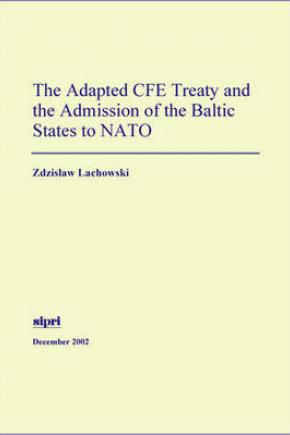The Adapted CFE Treaty and the Admission of the Baltic States to NATO
This original and timely study of the prospects for Europe's own regional disarmament regime—the adapted Treaty on Conventional Armed Forces in Europe—offers an antidote to several stereotypes including the one about the demise of arms control. It shows that the one treaty which par excellence could be viewed as a cold war instrument has managed to find a new rationale (or rather, several) during the past decade, and that its further extension may now complement, rather than conflict with, the spread of positive military integration to Europe's easternmost borders.
Twelve years after conventional arms control began in Europe, the process is about to enter a new, critical stage as it extends to cover the entire continent. Since the cold war, the situation in Europe and elsewhere has changed radically. The priorities, the rules of the game, and the groups and actors on the political stage are different. Consequently, ways of thinking about security and the options available are also changing.
In recent years momentous decisions have been taken regarding both the enlargement of the North Atlantic Treaty Organization and the adaptation of the conventional arms control regime. The invitation to Bulgaria, Estonia, Latvia, Lithuania, Romania, Slovakia and Slovenia to join the alliance, most likely in 2004, which was issued at the 21-22 November 2002 NATO summit meeting in Prague, will certainly affect the alliance's role as well as its shape.
Click here to download Policy Paper No. 1
Contents
1. Introduction
2. Adaptation of the CFE Treaty regime
3. Challenges to the adapted CFE Treaty regime
4. NATO membership for the Baltic states and the adapted CFE Treaty
5. The non-aligned Nordic states and the adapted CFE Treaty
6. Conclusions
Appendix. The adapted CFE Treaty
About the author
Dr Zdzislaw Lachowski (Poland) formerly worked at the Polish Institute of International Affairs in Warsaw. He has published extensively on the problems of European military security and arms control as well as on European politico-military integration. He has contributed to the SIPRI Yearbook since 1992. His recent publications include International Security in a Time of Change: Threats-Concepts-Institutions (co-editor with H.-J. Giessmann and R. Kuzniar, Nomos Verlag, 2004) and Confidence- and Security-building Measures in the New Europe (Oxford University Press, 2004)
1. Introduction
2. Adaptation of the CFE Treaty regime
3. Challenges to the adapted CFE Treaty regime
4. NATO membership for the Baltic states and the adapted CFE Treaty
5. The non-aligned Nordic states and the adapted CFE Treaty
6. Conclusions
Appendix. The adapted CFE Treaty


